【最新版导游词范本】荔波小七孔导游词英文
- 格式:doc
- 大小:36.00 KB
- 文档页数:8
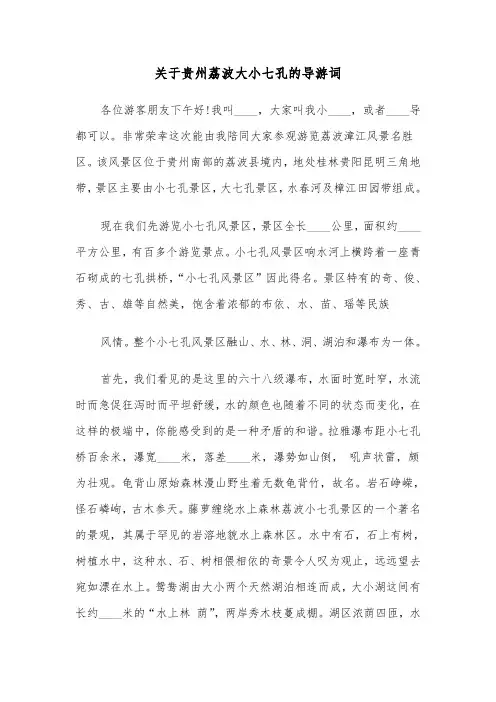
关于贵州荔波大小七孔的导游词各位游客朋友下午好!我叫____,大家叫我小____,或者____导都可以。
非常荣幸这次能由我陪同大家参观游览荔波漳江风景名胜区。
该风景区位于贵州南部的荔波县境内,地处桂林贵阳昆明三角地带,景区主要由小七孔景区,大七孔景区,水春河及樟江田园带组成。
现在我们先游览小七孔风景区,景区全长____公里,面积约____平方公里,有百多个游览景点。
小七孔风景区响水河上横跨着一座青石砌成的七孔拱桥,“小七孔风景区”因此得名。
景区特有的奇、俊、秀、古、雄等自然美,饱含着浓郁的布依、水、苗、瑶等民族风情。
整个小七孔风景区融山、水、林、洞、湖泊和瀑布为一体。
首先,我们看见的是这里的六十八级瀑布,水面时宽时窄,水流时而急促狂泻时而平坦舒缓,水的颜色也随着不同的状态而变化,在这样的极端中,你能感受到的是一种矛盾的和谐。
拉雅瀑布距小七孔桥百余米,瀑宽____米,落差____米,瀑势如山倒,吼声状雷,颇为壮观。
龟背山原始森林漫山野生着无数龟背竹,故名。
岩石峥嵘,怪石嶙峋,古木参天。
藤萝缠绕水上森林荔波小七孔景区的一个著名的景观,其属于罕见的岩溶地貌水上森林区。
水中有石,石上有树,树植水中,这种水、石、树相偎相依的奇景令人叹为观止,远远望去宛如漂在水上。
鸳鸯湖由大小两个天然湖泊相连而成,大小湖这间有长约____米的“水上林荫”,两岸秀木枝蔓成棚。
湖区浓荫四匝,水鸟相呼,境界幽绝。
置身其间,有如仙境。
乘橡皮舟顺水缓缓漂游而下,卧龙河生态长廊,全长____公里,两岸是葱茸秀丽的喀斯特原始植被,幽静的河水中,时而有鱼儿跃起,时而有秀美的岛屿出现,犹如精巧的天然盆景。
卧龙河的出口处有卧龙潭,暗河从崖底涌出,潭面上不见踪影,只有坝上雪崩似的滚水瀑布,潭外流不息的渠水。
潭边怪石奇树林立,古木森森,潭外水声轰鸣,雾雨蒙蒙,四周高山紧锁,水潭犹如地底深渊,即便涨洪水时,潭面也犹如镜子般平静现在,我们到了大七孔风景区。
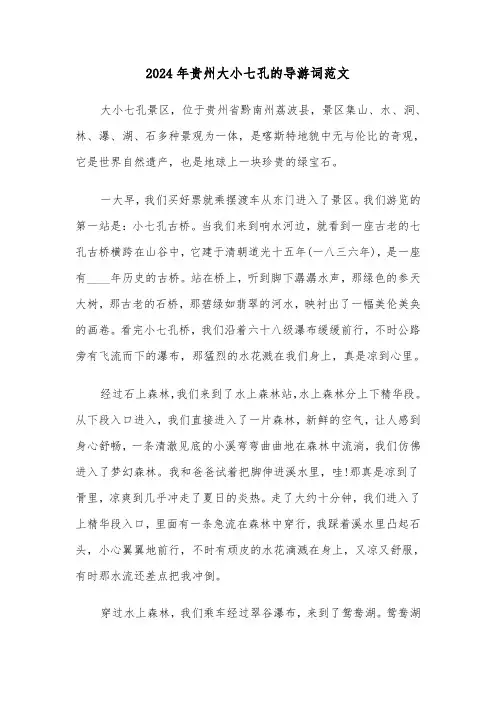
2024年贵州大小七孔的导游词范文大小七孔景区,位于贵州省黔南州荔波县,景区集山、水、洞、林、瀑、湖、石多种景观为一体,是喀斯特地貌中无与伦比的奇观,它是世界自然遗产,也是地球上一块珍贵的绿宝石。
一大早,我们买好票就乘摆渡车从东门进入了景区。
我们游览的第一站是:小七孔古桥。
当我们来到响水河边,就看到一座古老的七孔古桥横跨在山谷中,它建于清朝道光十五年(一八三六年),是一座有____年历史的古桥。
站在桥上,听到脚下潺潺水声,那绿色的参天大树,那古老的石桥,那碧绿如翡翠的河水,映衬出了一幅美伦美奂的画卷。
看完小七孔桥,我们沿着六十八级瀑布缓缓前行,不时公路旁有飞流而下的瀑布,那猛烈的水花溅在我们身上,真是凉到心里。
经过石上森林,我们来到了水上森林站,水上森林分上下精华段。
从下段入口进入,我们直接进入了一片森林,新鲜的空气,让人感到身心舒畅,一条清澈见底的小溪弯弯曲曲地在森林中流淌,我们仿佛进入了梦幻森林。
我和爸爸试着把脚伸进溪水里,哇!那真是凉到了骨里,凉爽到几乎冲走了夏日的炎热。
走了大约十分钟,我们进入了上精华段入口,里面有一条急流在森林中穿行,我踩着溪水里凸起石头,小心翼翼地前行,不时有顽皮的水花滴溅在身上,又凉又舒服,有时那水流还差点把我冲倒。
穿过水上森林,我们乘车经过翠谷瀑布,来到了鸳鸯湖。
鸳鸯湖是由两个大湖、四个小湖串联成的一个奇妙的湖泊,由下湖、水上迷宫、鸳鸯树、水上绿荫长廊组成,据说美国探险家贝尔曾在这拍过节目。
游湖必须划船,妈妈是第一次划,我又不会,爸爸也不是很会,我们的船一直往岸边靠,不前进。
我们想了一个又一个的办法,终于划动了,我也慢慢基本撑握了划船的方法。
行船在湖中,碧绿的湖水波光粼粼,旁边是来来往往的船只,水上绿荫长廊两边古木参天、苍翠欲滴,令人陶醉。
游完鸳鸯湖,我们坐车到了卧龙潭,发现这里已经是人山人海,于是我们就返程了。
回到东门后,我们休息了一会儿,爸爸说,既然游完了小七孔,我们应当要去看看大七孔呀。
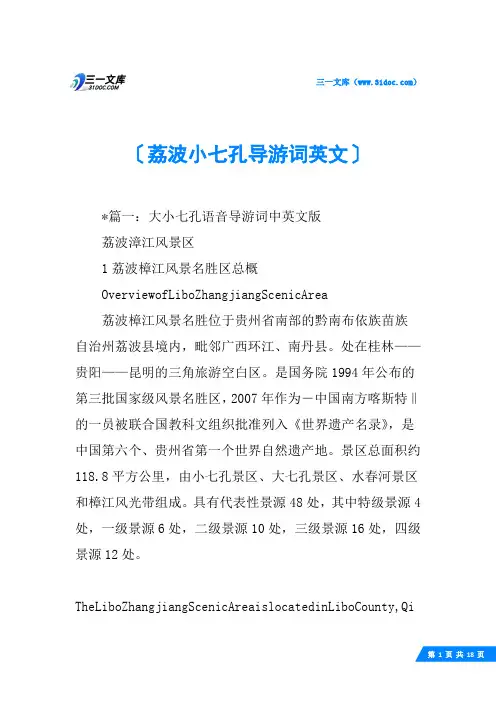
三一文库()〔荔波小七孔导游词英文〕*篇一:大小七孔语音导游词中英文版荔波漳江风景区1荔波樟江风景名胜区总概OverviewofLiboZhangjiangScenicArea荔波樟江风景名胜位于贵州省南部的黔南布依族苗族自治州荔波县境内,毗邻广西环江、南丹县。
处在桂林——贵阳——昆明的三角旅游空白区。
是国务院1994年公布的第三批国家级风景名胜区,2007年作为―中国南方喀斯特‖的一员被联合国教科文组织批准列入《世界遗产名录》,是中国第六个、贵州省第一个世界自然遗产地。
景区总面积约118.8平方公里,由小七孔景区、大七孔景区、水春河景区和樟江风光带组成。
具有代表性景源48处,其中特级景源4处,一级景源6处,二级景源10处,三级景源16处,四级景源12处。
TheLiboZhangjiangScenicAreaislocatedinLiboCounty,QiannanPrefectureinSouthGuizhouProvince,borderingHuan jiangandNandanofGuangxi.Itiswithinthetourismblanktr iangleofGuilin,GuiyangandKunming.Amongthe3rdbatchof nationallevelscenicareasproclaimedbytheStateCouncil in1994,itwaslistedintotheListofWorldHeritagesbytheU NESCOin2007asarepresentativeofSouthChinaKarst.ItisC hina’s6thandGuizhouProvince’sfirstworldnaturalheritagesite.Thescenicareacoversa totalareaof118.8km2,comprisingtheSmallSeven-holeSce nicArea,BigSeven-holeScenicArea,ShuichunRiverScenic Area,andZhangjiangRiverLandscapeBelt.Thereare48most representativeviewsources,amongwhich4arespecialgrad e,6arefirstgrade,10aresecondgrade,16arethirdgradean d12arefourthgrade.荔波樟江风景名胜区以典型、丰富、集中的喀斯特原始森林和喀斯特地貌上樟江水系的水景为基础,以千姿百态、独具特色的地貌景观、神奇茂密的原生植被、珍稀罕见的生物群种、绮丽多姿的真山真水为特色,以田园风光和底蕴深厚的少数民族风情为补充,特色鲜明,神秘奇特。
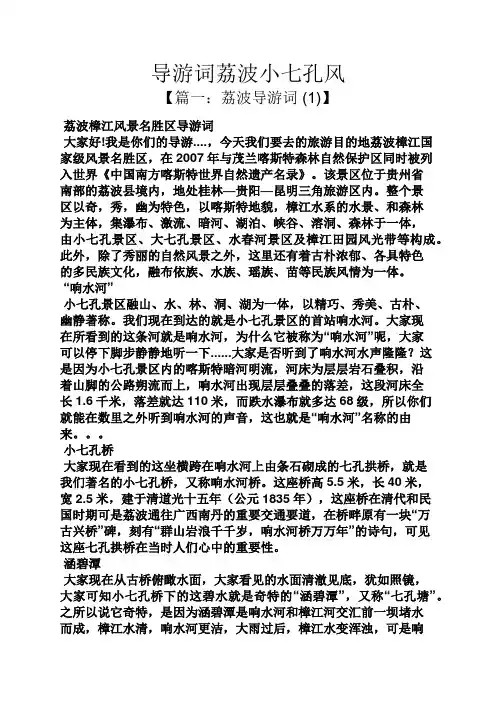
导游词荔波小七孔风【篇一:荔波导游词 (1)】荔波樟江风景名胜区导游词大家好!我是你们的导游....,今天我们要去的旅游目的地荔波樟江国家级风景名胜区,在2007年与茂兰喀斯特森林自然保护区同时被列入世界《中国南方喀斯特世界自然遗产名录》。
该景区位于贵州省南部的荔波县境内,地处桂林—贵阳—昆明三角旅游区内。
整个景区以奇,秀,幽为特色,以喀斯特地貌,樟江水系的水景、和森林为主体,集瀑布、激流、暗河、湖泊、峡谷、溶洞、森林于一体,由小七孔景区、大七孔景区、水春河景区及樟江田园风光带等构成。
此外,除了秀丽的自然风景之外,这里还有着古朴浓郁、各具特色的多民族文化,融布依族、水族、瑶族、苗等民族风情为一体。
“响水河”小七孔景区融山、水、林、洞、湖为一体,以精巧、秀美、古朴、幽静著称。
我们现在到达的就是小七孔景区的首站响水河。
大家现在所看到的这条河就是响水河,为什么它被称为“响水河”呢,大家可以停下脚步静静地听一下......大家是否听到了响水河水声隆隆?这是因为小七孔景区内的喀斯特暗河明流,河床为层层岩石叠积,沿着山脚的公路朔流而上,响水河出现层层叠叠的落差,这段河床全长1.6千米,落差就达110米,而跌水瀑布就多达68级,所以你们就能在数里之外听到响水河的声音,这也就是“响水河”名称的由来。
小七孔桥大家现在看到的这坐横跨在响水河上由条石砌成的七孔拱桥,就是我们著名的小七孔桥,又称响水河桥。
这座桥高5.5米,长40米,宽2.5米,建于清道光十五年(公元1835年),这座桥在清代和民国时期可是荔波通往广西南丹的重要交通要道,在桥畔原有一块“万古兴桥”碑,刻有“群山岩浪千千岁,响水河桥万万年”的诗句,可见这座七孔拱桥在当时人们心中的重要性。
涵碧潭大家现在从古桥俯瞰水面,大家看见的水面清澈见底,犹如照镜,大家可知小七孔桥下的这碧水就是奇特的“涵碧潭”,又称“七孔塘”。
之所以说它奇特,是因为涵碧潭是响水河和樟江河交汇前一坝堵水而成,樟江水清,响水河更洁,大雨过后,樟江水变浑浊,可是响水河依然清澈如常,在两河汇合处依旧泾渭分明,这可是喀斯特森林的特殊水文效应所形成的奇观,这也是其最为奇特的地方。
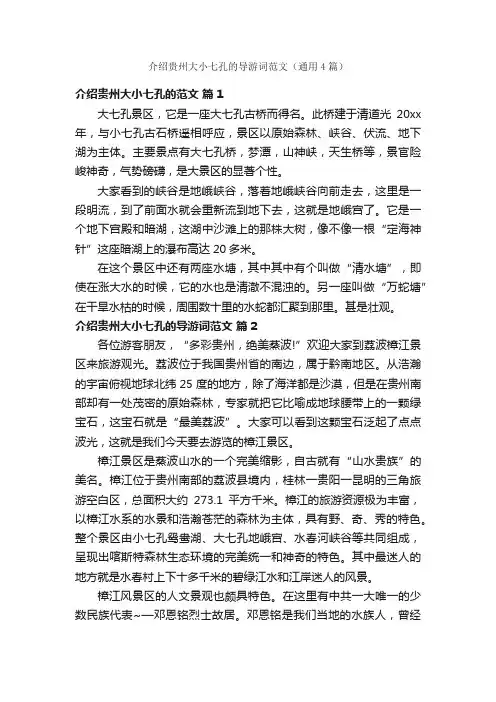
介绍贵州大小七孔的导游词范文(通用4篇)介绍贵州大小七孔的范文篇1大七孔景区,它是一座大七孔古桥而得名。
此桥建于清道光20xx 年,与小七孔古石桥遥相呼应,景区以原始森林、峡谷、伏流、地下湖为主体。
主要景点有大七孔桥,梦潭,山神峡,天生桥等,景官险峻神奇,气势磅礴,是大景区的显著个性。
大家看到的峡谷是地峨峡谷,落着地峨峡谷向前走去,这里是一段明流,到了前面水就会重新流到地下去,这就是地峨宫了。
它是一个地下宫殿和暗湖,这湖中沙滩上的那株大树,像不像一根“定海神针”这座暗湖上的瀑布高达20多米。
在这个景区中还有两座水塘,其中其中有个叫做“清水塘”,即使在涨大水的时候,它的水也是清澈不混浊的。
另一座叫做“万蛇塘”在干旱水枯的时候,周围数十里的水蛇都汇聚到那里。
甚是壮观。
介绍贵州大小七孔的导游词范文篇2各位游客朋友,“多彩贵州,绝美蒸波!”欢迎大家到荔波樟江景区来旅游观光。
荔波位于我国贵州省的南边,属于黔南地区。
从浩瀚的宇宙俯视地球北纬25度的地方,除了海洋都是沙漠,但是在贵州南部却有一处茂密的原始森林,专家就把它比喻成地球腰带上的一颗绿宝石,这宝石就是“最美荔波”。
大家可以看到这颗宝石泛起了点点波光,这就是我们今天要去游览的樟江景区。
樟江景区是蒸波山水的一个完美缩影,自古就有“山水贵族”的美名。
樟江位于贵州南部的荔波县境内,桂林一贵阳一昆明的三角旅游空白区,总面积大约273.1平方千米。
樟江的旅游资源极为丰富,以樟江水系的水景和浩瀚苍茫的森林为主体,具有野、奇、秀的特色。
整个景区由小七孔鸳鸯湖、大七孔地峨宫、水春河峡谷等共同组成,呈现出喀斯特森林生态环境的完美统一和神奇的特色。
其中最迷人的地方就是水春村上下十多千米的碧绿江水和江岸迷人的风景。
樟江风景区的人文景观也颇具特色。
在这里有中共一大唯一的少数民族代表~—邓恩铭烈士故居。
邓恩铭是我们当地的水族人,曾经和王尽美组织过励新学会、发起并且建立了济南的共产党早期组织。
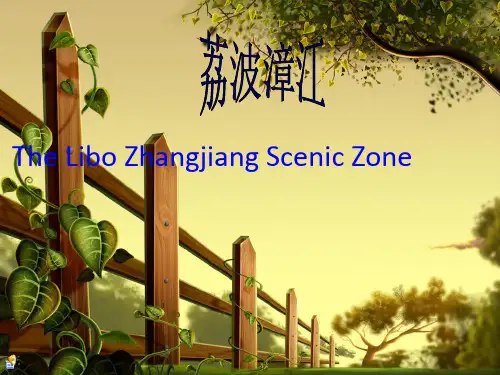
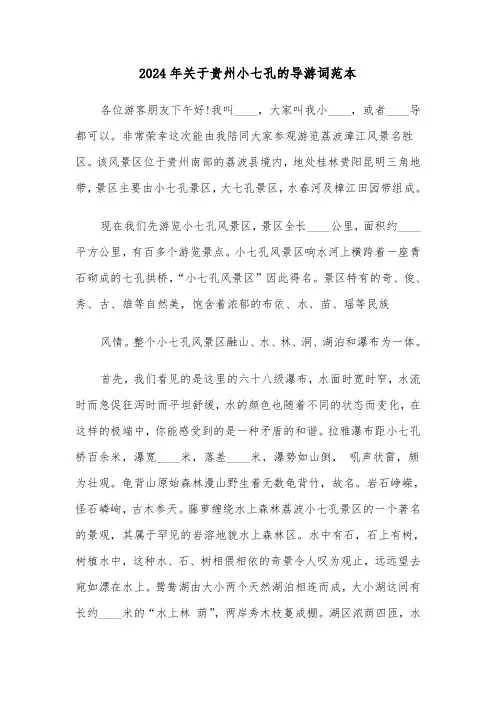
2024年关于贵州小七孔的导游词范本各位游客朋友下午好!我叫____,大家叫我小____,或者____导都可以。
非常荣幸这次能由我陪同大家参观游览荔波漳江风景名胜区。
该风景区位于贵州南部的荔波县境内,地处桂林贵阳昆明三角地带,景区主要由小七孔景区,大七孔景区,水春河及樟江田园带组成。
现在我们先游览小七孔风景区,景区全长____公里,面积约____平方公里,有百多个游览景点。
小七孔风景区响水河上横跨着一座青石砌成的七孔拱桥,“小七孔风景区”因此得名。
景区特有的奇、俊、秀、古、雄等自然美,饱含着浓郁的布依、水、苗、瑶等民族风情。
整个小七孔风景区融山、水、林、洞、湖泊和瀑布为一体。
首先,我们看见的是这里的六十八级瀑布,水面时宽时窄,水流时而急促狂泻时而平坦舒缓,水的颜色也随着不同的状态而变化,在这样的极端中,你能感受到的是一种矛盾的和谐。
拉雅瀑布距小七孔桥百余米,瀑宽____米,落差____米,瀑势如山倒,吼声状雷,颇为壮观。
龟背山原始森林漫山野生着无数龟背竹,故名。
岩石峥嵘,怪石嶙峋,古木参天。
藤萝缠绕水上森林荔波小七孔景区的一个著名的景观,其属于罕见的岩溶地貌水上森林区。
水中有石,石上有树,树植水中,这种水、石、树相偎相依的奇景令人叹为观止,远远望去宛如漂在水上。
鸳鸯湖由大小两个天然湖泊相连而成,大小湖这间有长约____米的“水上林荫”,两岸秀木枝蔓成棚。
湖区浓荫四匝,水鸟相呼,境界幽绝。
置身其间,有如仙境。
乘橡皮舟顺水缓缓漂游而下,卧龙河生态长廊,全长____公里,两岸是葱茸秀丽的喀斯特原始植被,幽静的河水中,时而有鱼儿跃起,时而有秀美的岛屿出现,犹如精巧的天然盆景。
卧龙河的出口处有卧龙潭,暗河从崖底涌出,潭面上不见踪影,只有坝上雪崩似的滚水瀑布,潭外流不息的渠水。
潭边怪石奇树林立,古木森森,潭外水声轰鸣,雾雨蒙蒙,四周高山紧锁,水潭犹如地底深渊,即便涨洪水时,潭面也犹如镜子般平静现在,我们到了大七孔风景区。
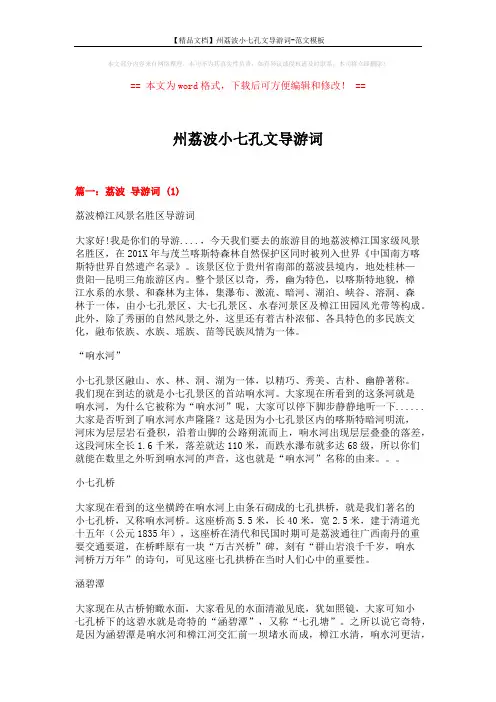
本文部分内容来自网络整理,本司不为其真实性负责,如有异议或侵权请及时联系,本司将立即删除!== 本文为word格式,下载后可方便编辑和修改! ==州荔波小七孔文导游词篇一:荔波导游词 (1)荔波樟江风景名胜区导游词大家好!我是你们的导游....,今天我们要去的旅游目的地荔波樟江国家级风景名胜区,在201X年与茂兰喀斯特森林自然保护区同时被列入世界《中国南方喀斯特世界自然遗产名录》。
该景区位于贵州省南部的荔波县境内,地处桂林—贵阳—昆明三角旅游区内。
整个景区以奇,秀,幽为特色,以喀斯特地貌,樟江水系的水景、和森林为主体,集瀑布、激流、暗河、湖泊、峡谷、溶洞、森林于一体,由小七孔景区、大七孔景区、水春河景区及樟江田园风光带等构成。
此外,除了秀丽的自然风景之外,这里还有着古朴浓郁、各具特色的多民族文化,融布依族、水族、瑶族、苗等民族风情为一体。
“响水河”小七孔景区融山、水、林、洞、湖为一体,以精巧、秀美、古朴、幽静著称。
我们现在到达的就是小七孔景区的首站响水河。
大家现在所看到的这条河就是响水河,为什么它被称为“响水河”呢,大家可以停下脚步静静地听一下......大家是否听到了响水河水声隆隆?这是因为小七孔景区内的喀斯特暗河明流,河床为层层岩石叠积,沿着山脚的公路朔流而上,响水河出现层层叠叠的落差,这段河床全长1.6千米,落差就达110米,而跌水瀑布就多达68级,所以你们就能在数里之外听到响水河的声音,这也就是“响水河”名称的由来。
小七孔桥大家现在看到的这坐横跨在响水河上由条石砌成的七孔拱桥,就是我们著名的小七孔桥,又称响水河桥。
这座桥高5.5米,长40米,宽2.5米,建于清道光十五年(公元1835年),这座桥在清代和民国时期可是荔波通往广西南丹的重要交通要道,在桥畔原有一块“万古兴桥”碑,刻有“群山岩浪千千岁,响水河桥万万年”的诗句,可见这座七孔拱桥在当时人们心中的重要性。
涵碧潭大家现在从古桥俯瞰水面,大家看见的水面清澈见底,犹如照镜,大家可知小七孔桥下的这碧水就是奇特的“涵碧潭”,又称“七孔塘”。
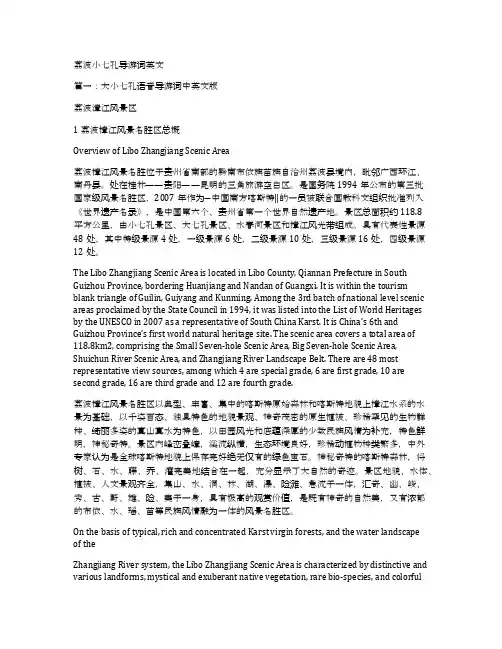
荔波小七孔导游词英文篇一:大小七孔语音导游词中英文版荔波漳江风景区1 荔波樟江风景名胜区总概Overview of Libo Zhangjiang Scenic Area荔波樟江风景名胜位于贵州省南部的黔南布依族苗族自治州荔波县境内,毗邻广西环江、南丹县。
处在桂林——贵阳——昆明的三角旅游空白区。
是国务院1994年公布的第三批国家级风景名胜区,2007年作为―中国南方喀斯特‖的一员被联合国教科文组织批准列入《世界遗产名录》,是中国第六个、贵州省第一个世界自然遗产地。
景区总面积约118.8平方公里,由小七孔景区、大七孔景区、水春河景区和樟江风光带组成。
具有代表性景源48处,其中特级景源4处,一级景源6处,二级景源10处,三级景源16处,四级景源12处。
The Libo Zhangjiang Scenic Area is located in Libo County, Qiannan Prefecture in South Guizhou Province, bordering Huanjiang and Nandan of Guangxi. It is within the tourism blank triangle of Guilin, Guiyang and Kunming. Among the 3rd batch of national level scenic areas proclaimed by the State Council in 1994, it was listed into the List of World Heritages by the UNESCO in 2007 as a representative of South China Karst. It is China’s 6th and Guizhou Province’s first world natural heritage site. The scenic area covers a total area of 118.8km2, comprising the Small Seven-hole Scenic Area, Big Seven-hole Scenic Area, Shuichun River Scenic Area, and Zhangjiang River Landscape Belt. There are 48 most representative view sources, among which 4 are special grade, 6 are first grade, 10 are second grade, 16 are third grade and 12 are fourth grade.荔波樟江风景名胜区以典型、丰富、集中的喀斯特原始森林和喀斯特地貌上樟江水系的水景为基础,以千姿百态、独具特色的地貌景观、神奇茂密的原生植被、珍稀罕见的生物群种、绮丽多姿的真山真水为特色,以田园风光和底蕴深厚的少数民族风情为补充,特色鲜明,神秘奇特。

小七孔景区导游词【篇一:荔波导游词】荔波樟江风景名胜区导游词大家好!我是你们的导游....,今天我们要去的旅游目的地荔波樟江国家级风景名胜区,在2007年与茂兰喀斯特森林自然保护区同时被列入世界《中国南方喀斯特世界自然遗产名录》。
该景区位于贵州省南部的荔波县境内,地处桂林—贵阳—昆明三角旅游区内。
整个景区以喀斯特地貌和樟江水系的水景、浩瀚苍茫的森林为主体,集瀑布、激流、暗河、湖泊、峡谷、溶洞、森林为一体,融奇、幽、险、峻、雄、秀为一炉,包括小七孔景区、大七孔景区、水春河景区及樟江田园风光带等构成。
此外,除了秀丽的自然风景之外,这里还有着古朴浓郁、各具特色的多民族文化,融布依、水、瑶、苗等民族风情为一体。
今天我们主要要带大家前往的是著名的小七孔景区以及樟江风光最为秀丽的水春河景区。
让我们开始我们愉快的旅行吧!小七孔景区融山、水、林、洞、湖为一体,以精巧、秀美、古朴、幽静著称。
我们现在到达的就是小七孔景区的首站响水河。
大家现在所看到的这条河就是响水河,为什么它被称为“响水河”呢,大家可以停下脚步静静地听一下......大家是否听到了响水河水声隆隆?这是因为小七孔景区内的喀斯特暗河明流,河床为层层岩石叠积,沿着山脚的公路朔流而上,响水河出现层层叠叠的落差,这段河床全长1.6千米,落差就达110米,而跌水瀑布就多达68级,所以你们就能在数里之外听到响水河的声音,这也就是“响水河”名称的由来。
大家现在看到的这坐横跨在响水河上由条石砌成的七孔拱桥,就是我们著名的小七孔桥,又称响水河桥。
这座桥高5.5米,长40米,宽2.5米,建于清道光十五年(公元1835年),这座桥在清代和民国时期可是荔波通往广西南丹的重要交通要道,在桥畔原有一块“万古兴桥”碑,刻有“群山岩浪千千岁,响水河桥万万年”的诗句,可见这座七孔拱桥在当时人们心中的重要性。
大家现在从古桥俯瞰水面,大家看见的水面清澈见底,犹如照镜,大家可知小七孔桥下的这碧水就是奇特的“涵碧潭”,又称“七孔塘”。
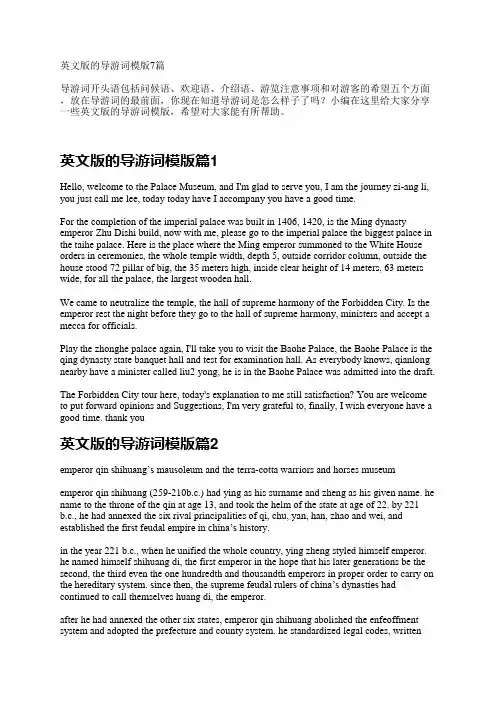
英文版的导游词模版7篇导游词开头语包括问候语、欢迎语、介绍语、游览注意事项和对游客的希望五个方面,放在导游词的最前面,你现在知道导游词是怎么样子了吗?小编在这里给大家分享一些英文版的导游词模版,希望对大家能有所帮助。
英文版的导游词模版篇1Hello, welcome to the Palace Museum, and I'm glad to serve you, I am the journey zi-ang li, you just call me lee, today today have I accompany you have a good time.For the completion of the imperial palace was built in 1406, 1420, is the Ming dynasty emperor Zhu Dishi build, now with me, please go to the imperial palace the biggest palace in the taihe palace. Here is the place where the Ming emperor summoned to the White House orders in ceremonies, the whole temple width, depth 5, outside corridor column, outside the house stood 72 pillar of big, the 35 meters high, inside clear height of 14 meters, 63 meters wide, for all the palace, the largest wooden hall.We came to neutralize the temple, the hall of supreme harmony of the Forbidden City. Is the emperor rest the night before they go to the hall of supreme harmony, ministers and accept a mecca for officials.Play the zhonghe palace again, I'll take you to visit the Baohe Palace, the Baohe Palace is the qing dynasty state banquet hall and test for examination hall. As everybody knows, qianlong nearby have a minister called liu2 yong, he is in the Baohe Palace was admitted into the draft. The Forbidden City tour here, today's explanation to me still satisfaction? You are welcome to put forward opinions and Suggestions, I'm very grateful to, finally, I wish everyone have a good time. thank you英文版的导游词模版篇2emperor qin shihuang’s mausoleum and the terra-cotta warriors and horses museum emperor qin shihuang (259-210b.c.) had ying as his surname and zheng as his given name. he name to the throne of the qin at age 13, and took the helm of the state at age of 22. by 221 b.c., he had annexed the six rival principalities of qi, chu, yan, han, zhao and wei, and established the first feudal empire in china’s history.in the year 221 b.c., when he unified the whole country, ying zheng styled himself emperor. he named himself shihuang di, the first emperor in the hope that his later generations be the second, the third even the one hundredth and thousandth emperors in proper order to carry on the hereditary system. since then, the supreme feudal rulers of china’s dynasties had continued to call themselves huang di, the emperor.after he had annexed the other six states, emperor qin shihuang abolished the enfeoffment system and adopted the prefecture and county system. he standardized legal codes, writtenlanguage, track, currencies, weights and measures. to protect against harassment by the hun aristocrats. emperor qin shihuang ordered the great wall be built. all these measures played an active role in eliminating the cause of the state of separation and division and strengthening the unification of the whole country as well as promotion the development of economy and culture. they had a great and deep influence upon china’s 2,000 year old feudal society. emperor qin shihuang ordered the books of various schools burned except those of the qin dynasty’s hi story and culture, divination and medicines in an attempt to push his feudal autocracy in the ideological field. as a result, china’s ancient classics had been devastated and destroy. moreover, he once ordered 460 scholars be buried alive. those events were later called in history“the burning of books and the burying of confucian scholars.”emperor qin shihuang,for his own pleasure, conscribed several hundred thousand convicts and went in for large-scale construction and had over seven hundred palaces built in the guanzhong plain. these palaces stretched several hundred li and he sought pleasure from one palace to the other. often nobody knew where he ranging treasures inside the tomb, were enclosed alive.emperor qin shihuang’s mausoleum has not yet been ex cavated. what looks like inside could noly be known when it is opened. however, the three pits of the terra-cotta warriot excavated outside the east gate of the outer enclosure of the necropolis can make one imagine how magnificent and luxurious the struct ure of emperor qin shihuang’s mausoleum was.no.1 pit was stumbled upon in march 1974 when villagers of xiyang village of yanzhai township, lintong county, sank a well 1.5km east of the mausoleum. in 1976, no.2 and 3 pits were found 20m north of no.1 pit respectively after the drilling survey. the terra-cotta warriors and horses are arrayed according to the qin dynasty battle formation, symbolizing the troops keeping vigil beside the mausoleum. this discovery aroused much interest both at home and abroad. in 1975, a museum, housing the site of no.1 and covering an area of 16,300 square meters was built with the permission of the state council. the museum was formally opened to public on oct.1, the national day, 1979.no.1 pit is 230 meters long from east to west, 62m wide from north to south and 5m deep , covering a total area of 14,260 square meters. it is an earth-and-wood structure in the shape of a tunnel. there are five sloping entrances on the eastern and western sides of the pit respectively. the pit is divided into eleven corridors by ten earthen partition walls, and the floors are paved with bricks. thick rafters were placed onto the walls (but now one can only see their remains), which were covered with mats and then fine soil and earth. the battle formation of the qin dynasty, facing east. in the east end are arrayed three lines of terra-cotta warriors, 70 pieces in each, totaling 210 pieces. they are supposed to be the van of the formation. immediately behind them are 38 columns of infantrymen alternating with war chariots in the corridors, each being 180m long. they are probably the main body of the formation. there is one line of warriors in the left, right and west ends respectively, facing outwards. they are probably the flanks and the rear. there are altogether 27 trial trench, it is assumed that more than 6,000 clay warriors and horses could be unearthed from no.1 pit. no.2 pit sis about half the size of no.1 pit, covering about 6,000 square meters trail diggings show this is a composite formation of infantry, cavalry and chariot soldiers, from which roughly over 1,000 clay warriors, and 500 chariots and saddled horses could be unearthed. the 2,000-year-old wooden chariots are already rotten. but their shafts, cross yokes, andwheels, etc. left clear impressions on the earth bed. the copper parts of the chariots still remain. each chariot is pulled by four horses which are one and half meters high and two metres long. according to textual research, these clay horses were sculptures after the breed in the area of hexi corridor. the horses for the cavalrymen were already saddled, but with no stirups.no.3 pit covers an area of 520m2 with only four horses, one chariot and 68 warriors, supposed to be the command post of the battle formation. now, no.2 and 3 pits have been refilled, but visitors can see some clay figures and weapons displayed in the exhibition halls in the museum that had been unearthed from these two pits. the floors of both no.1 and 2 pits were covered with a layer of silt of 15 to 20cm thick. in these pits, one can see traces of burnt beams everywhere, some relics which were mostly broken. analysis shows that the pits were burned down by xiang yu, leader of a peasant army. all of the clay warriors in the three pits held real weapons in their hands and face east, showing emperor qin shihuang’s strong determination of wiping out the six states and unifying the whole country.the height of the terra-cotta warriors varies from 1.78m, the shortest, to 1.97m, the tallest. they look healthy and strong and have different facial expressions. probably they were sculpted by craftsmen according to real soldiers of the qin dynasy. they organically combined the skills of round engraving, bas-relief and linear engraving, and utilized the six traditional folk crafts of sculpturing, such as hand-moulding, sticking, cutting, painting and so on. the clay models were then put in kilns, baked and colour-painted. as the terra-cotta figures have beeb burnt and have gone through the natural process of decay, we can’t see their original gorgeous colours. however, most of the terra-cotta figures bear the trace of the original colours, and few of them are still as bright as new. they are found to be painted by mineral dyestuffs of vermilion, bright red, pink dark green, powder green, purple, blue, orange, black and white colours.thousands of real weapons were unearthed from these terra-cotta army pits, including broad knives, swords, spears, dagger-axes, halberds, bows, crossbows and arrowheads. these weapons were exquisitely made. some of theme are still very sharp, analyses show that they are made of alloys of copper and tin, containing more than ten kinds of other metals. since their surfaces were treated with chromium, they are as bright as new, though buriedund erground for more than 2,000 years. this indicates that qin dynasty’s metallurgical technology and weapon-manufacturing technique already reached quite a high level.in december 1980, two teams of large painted bronze chariots and horses were unearthed 20 metres west of the mound of emperor qin shihuang’s mausoleum. these single shaft four-horse chariots each comprises 3,462 spare parts, and has a body with two compartments, one behind the other, and an elliptical umbrella like canopy. the four horses harnessed to the chariot are 65-67 centimeters tall. the restored bronze chariots and horses are exact imitations of true chariot, horse and driver in half life-size.the chariots and horses are decorated with coloured drawings against white background. they have been fitted with more than 1,500 piecese of gold and silvers and decorations, looking luxurious, splendid and graceful. probably they were meant for the use of emperor qin shihuang’s soul to go on inspection. the bronze chariots and horses were made by lost wax casting, which shows a high level of technology. for instance, the tortoise-shell-like canopy is about 4mm thick, and the window is only 1mm thick on which are many small holes for ventilation. according to a preliminary study, the technology of manufacturing the bronzechariots and horses has involved casting, welding, reveting, inlaying embedding and chiseling. the excavation of the bronze chariots and horses provides extremely valuable material and data for the textual research of the metallurgical technique, the mechanism of the chariot and technological modeling of the qin dynasty.no.2 bronze chariot and horses now on display were found broken into 1,555 pieces when excavated. after two-and-half years’ careful and painstaking restoration by ar chaeologists and various specialists, they were formally exhibited in the museum on october 1, 1983. no.1 bronze chariot hand horses are on display from 1988.英文版的导游词模版篇3the great mosque at huajue lanethe mosque is a major spot for religious activities of over 60.000 moslems in xi’an, likewise, an important cultural relic protected by the provincial people’s government. unlike the arabic mosques, with splendid domes, the minarets reaching into the clouds, the coulourful engraved sketches with dazzling pa tterns, the mosque here in xi’an possesses much chinese traditional touch in both its design and artistic outlook; besides the style peculiar to islamic mosques, this mosque also holds characteristics of chinese pavilions with painted beams and engraved ridgepoles.however, any further discussion about the mosque will be futile unless anything of the introduction of islam into china is brought up.islam as a religious order was founded in the early period of the 7th century a.d. and was introduced to china in the mid-600s. at that time, arabian merchants and travelers came to the northwest of china by way of persia and afghanistan and thus established diplomatic, trade, and military contacts with china. in the meantime, another route saw a batch of sea voyagers through bangladesh bay and the malacca strait to china’s guangzhou, quanzhou, huangzhou, yangzhou and other cities where many of them settled down and married the local women who later gave birth to babies who then became moslems.however, massive immigration of the moslems to china did not take place until as late as the early period of the 13th century, when genghis khan, as a result of his expedition against the west, had conquered vast expanses of land stretching from central asia to eastern europe, including the north of iran. many of the moslems in the conquered areas were thus forced to enlist and later settled in china.among the enlisted many were soldiers, and some were smiths and officials who were called the hui people in the history books on the yuan dynasty. the hui people later followed kublai khan down to the south, helping him unifying china and then establish the yuan dynasty. in the wake of the conquest, islam spread all over china and mosques began to appear everywhere. in the yuan dynasty, many moslems held positions both in the military and civilian organs of the country. and a lot of the moslems took part in zhu yuanzhang’s uprising in the early 14th century and made great contributions to the founding of the ming dynasty. therefore, all the emperors of the dynasty issued mandates to protect islam, and to set up mosques in praise of the moslems for their feats. in the early 16th century, islam predominated qinghai on the minority nationalities including the huis, the uygurs, the kazaks,the kirgizes, the tajiks, the tartars, the ozbeks, the dong xiangs, the salars and the bonans. the moslems in xi’an are mainly the huis, being a small portion out of the ten million in china.the mosque at hua jue lane is the largest in xi’an, and at th e same time, it is also one of the earliest built on a comparatively large scale, and well preserved mosques in china.according to “the stele on the building of the mosque”, the mosque is said to be built in the tang dynasty. however, the architectural style of the mosque suggests a possible building dating back to the ming dynasty. the four courtyards of the mosque cover an area of more than 12,000 square meters, out of which about 4,000 are occupied by various structures. the still intact wooden front memorial gateway of the front yard, built at the turn of the 17th century, with glazed tiles on the top, spectacular corners and upturned eaves, is about 9 metres high, and has a history of about 360 years. the stone memorial gateway in the center of the second courtyard is flanked with a tail stele on either side with dragons carved on each, recording the repair work ever since the building of the mosque. on the back of one of the steles are engraved characters by the master calligrapher mi fu, “may buddhism fill the universe”, on the other, “royal -bestowed”by dong qichang, another master of the same art of the ming dynasty. they are treasures in chinese calligraphy. at the entrance of the third courtyard is an imperial built hall, where a “month tablet”, sh owing the calculation of the hui calendars in arabic, is stored. it was compiled by a man in charge of the mosque called xiao mining in the early period of the qing dynasty. a three –storeyed octagonal wooden structure called “retrospection tower”also stan ds in the center of the courtyard, which has the same function as the minaret in islamic temples in arabic countries, and which is a place from where orders were sent to call the moslems to come to worship. respectively, on the south and north wings of the tower, are a reception chamber and a scripture chamber, both elegantly laid out. the five wooden houses, which are called “water houses”in the southwest section of the mosque are the place where the believers bathe themselves before they attend theirserv ices. and in side the fourth courtyard there is a structure called “the pavilion of phoenix”, a place where the worshipers used to wait for the services. the pavilion, in fact, is a compound structure of three small buildings. the six-gabled structure of the central part, adjoining the two three-gabled buildings on each side looks very much like a flying phoenix, and hence its name. just at the back of the pavilion, there is a fishpond, beyond which is a platform occupying an area as large as 700 m2. across both ends of the platform stands the 1,300 square metered service hall, holding over a thousand worshipers at once. there are over six hundred sunk panels well as the sunk panels, are decorated with patterns of painted trailing plants and arabic letterings. the imam leads his group of worshipers, while facing in the direction of mecca, to chant in koran and to pay their religious homage.the moslems in china share very much the same customs with their brothers and sisters elsewhere in the world. they worship five times a day: at dawn, at noon, in the afternoon, at dusk, and at night. female worshipers attend their services in a separated place from their brothers, usually at home. moslems pay special attention to their health and see that they always wear clean clothes. they are teetotalers not only of wine, but also of pork and animal blood for in koran pigs have been mentioned four times as being “unclean”. according to koran, a man can have four wives and women should wear veils when they go out. however, except a few places in xinjiang, the chinese practise monogamy and women are veiless when they go out. upon his death, a moslem has to be “thoroughly cleaned”(thoroughly bathed), has to be put on “ke fan”(to be shrouded with a piece of white cloth) and ha s to be buried coffinless in the ground, with an imam reciting scriptures at the funeral.the chinese constitution promulgates that freedom of religion of each citizen and freedom of preserving or reforming local customs for every nationality are permitted. and of course, the moslems in china enjoy equal rights with peoples of other nationalities and their religious beliefs and customs are respected everywhere in the country.英文版的导游词模版篇4good morning! ladies and gentlemen! today, with such great joy, on behalf of anhui travel agency. i’d like to extend our warm welcome to all of you, our distinguished guest from the other side of the pacific. please allow me to introduce myself. my name is li xin and i work for anhui travel agency .during your short stay in huangshan, i’ll be your local guide. it’s my honor to be of your service. if you have any request, go ahead! i’ll try my best to help you and make your stay comfortable!ok, now, we’re heading for qiyun mount. it’s about 30 minutes’ bus ride. on the way yo u can enjoy the beautiful scenery and i’d like to give you a brief introduction about mt.qiyun.mt.qiyun is situated in xiuning county of southern anhui, formerly known as “white mountain”. it’s now called “qi yun”, which means “as much high as the clouds” with a peak poking into the sky.mt.qiyun, together with the yellow mountain and jiuhua mountain, has always enjoyed the reputation of “three famous mountains in southern anhui”. over about 500 years ago, one emperor in chinese history praised it as the first mountain in south of yangtze river. and since 1,300 years ago, it has been chosen as one of the “four taoism holy lands” in china.mt.qiyun covers a scenic area of 110 square kilometers. it is the rising part of the yellow mountain extending southwest to the edge of southern anhui basin. the mountain ranges from northeast to southwest, with highest peak of 585 meters above sea level. composed by purplish and erinaceous rock and grit, the mountain has been shaped into the unique “red cloud land form” by long-time weathering and erosion. at present, there has been 300 scenic spots in qiyun mount, among which are 50 wonderful peaks, 49 odd rocks, 16 deep caves, 46 nice stream and 25 places of ridges, stairs and terraces. all these go into the making of the natural beauty here. the three major scenic areas are: yuehua street, yunyan lake and longshang lou.ok, i have said too much about mt.qiyun. i expect you have got a general idea about it. seeing is believing. let’s get off the bus and brings your camera, i will show you around the mountain!look! the first sight that comes to us is dengfeng bridge, which leads to the mountain passage. come on! let’s close it! do you know why it called “dengfeng” bridge, and “dengfeng” which means “being promoted”. it is s aid that the bridge can bring people gook luck and longevity. today you came here and you can have good luck and longevity. long long ago, there is a local governor, who would build bridges for the good of the people, has won their respect and love. just as the bridge was going to be named, the imperial edict came announcing the promotion of the governor. thus, the crowed congratulated the governor and gave the bridge the name “dengfeng”. ok! let’s go on visiting! then we will pass six pavilions one by one on our way up the mountain. each has its names and different pictures painting on the ceilings.they are buyun pavilions, denggao pavilions, yingfeng pavilions, songyue pavilions, haitianyiwang pavilions and wangxian pavilions.now, here is wangxian terrace which means expecting the fairy is the leading scenic spot of the fairy pass with feiyun pavilion on it. you see this bridge called mengzhen bridge means dream comes true. let’s pass it and maybe our dreams will come true! now, this is shouzi cliff, and that huge character “shou” means longevity is engraved. you can take a picture! it’s 230cm in diameter. are you ok? a few steps ahead are the first heaven gate. you see the peak is in the shape of an elephant, and the cave looks just like the huge trunk of it. thus, it is also called trunk hill. come on! eyes front! a tremendous stone inscription high up on the cliffs! stone carving is a distinctive feature of qiyun mountain. here, you see four chinese charactors “tian kai shen xiu” which means heaven created the beauty is the fairy’s caves, which is one of the best spots of the mountain. and you can see so many carved figures here! we can take a short rest here and then we’ll get up to the second heaven gate and the third heaven gate, then we’ll arrive at t he hinterland of qiyun mount-yuehua street. the street used to be place for taoists to practice martial art and make immortality pills. there had been a number of magnificent taoist shines and buildings, but most of them were damaged as the time passes by only 8 temples have been well-preserved, and several others have been rebuilt. such as yuxu temple and zhenxu hall. also we’ll visit fangla zhai ahead of yuehua street, and the highest peak of qiyun mount, --guoyan, which is another wonderful spot with its stone inscription. 英文版的导游词模版篇5Although Changchun has been more than 200 years old, it is still a young city comparing other historical cities in China, like Xian. Being the capital city of Jilin Province , Changchun is the political, economic and cultural center. If territory of China is in a shape of rooster, therefore Changchun is one eye of this huge rooster. You can imagine its important position. Spring City of Northland: The four seasons varies a lot and the climate is rather pleasant, therefore Changchun is honored Spring City of Northland. 39% of Changchun ground has been clothed with greenage, which makes Changchun one of top cities in this aspect. Green plants in and around Changchun make the city become a big oxygen bar, providing people to enjoy real fresh air.City of Automobiles: Changchun is the cradle of Chinese automobile industry, a famous auto city in China. On July 13, 1956, a truck branded with Jiefang was produced, which opened a new age for Chinese auto industry. This truck was the first automobile entirely made by Chinese. Famous and Changchun International Automobile Fair makes Changchun a real City of Automobiles.City of Films: Changchun Film Studio was the first one after the establishment of People's Republic of China. It is praised as the cradle of Chinese film industry. For dozens of years, a great many excellent films were produced here which gained a good fame for Changchun Film Studio both at home and abroad. As a calling card of Changchun, ceremonious Changchun Film Festival has enhanced its honor City of Film. People outside Changchun have known more about this city through film; while Changchun has presented more of itself by films.It is undeniable that Changchun is also a good travel destination. The natural sceneries of Changchun lie in lakes and forests. Nanhu Park (South Lake Park), Jingyuetan NationalForest Park are good places for you to enjoy the pleasure given by nature. Especially in winter the whole Changchun city will give you a real enjoyment of genuine winter. Besides, there are colonial vestiges, such as Puppet Emperor's Palace. Still Changchun Film Studio and Changchun Movie City provide you another different kind of enjoyment comparing with simply watching movies in cinemas.As the fast development of tourist industry, those related tourist facilities in Changchun are also in a quick growth. Nowadays there are more than 30 star-rated hotels in Changchun, among which three hotels are five-star rated.51 trains begin or pass by Changchun Railway Station everyday; more than thirty domestic airlines and four international lines of Changchun Longjia International Airport provide you much convenience of transportation. Four main speedways have connected Changchun with many parts of China.Nightlife of Changchun is not as colorful and romantic as that of other big cities in China, such as Shanghai, Beijing, however, it has its own distinctive flavor which can be only known after you taste it in person. Various kinds of pubs, coffee bars, teahouses and other amusement centers will make you feel at ease.英文版的导游词模版篇6Ladies and gentlemen, today we are going to visit a famous Buddhist temple---the Jade Buddha Temple.Before visiting the temple, I’d like to say a few words about the religious situation in Shanghai. Our constitution stipulates that every Chinese citizen is ensured the freedom of religious belief. There are four major religions in practice in Shanghai, namely, Buddhism, Taoism, Islam, and Christianity, which is sub-divided into the Catholic Church and the Protestant Church. When it comes to Buddhist temples in China, they are usually classified into three sects, i.e. temples for meditation, for preaching and for practicing Buddhist disciplines. The Jade Buddha Temple is a temple for meditation, and is well-known both at home and abroad.The temple was first built during the reign of Emperor Guangxu of Qing Dynasty, when a monk named Hui Gen went on a pilgrimage to Burma and brought back five jade statues of Sakyamuni. On his way back to Mount Putuo via Shanghai, he left two jade statues here, one in sitting posture and the other, reclining. He had a temple specially built as a shrine for these two statues in 1882. later the temple waspartly destroyed by fire and in 1928 a new temple was completed on the present site.Just opposite the temple gate, there stands a giant screen wall. Various designs, such as dragon, phoenix, elephant, crane and peony are carved on it. In Chinese legend, all these things are considered the symbols of fortune, wealth, longevity and auspiciousness. Chinese people used to set up a wall in front of the house so as to keep the evils away.Now ladies and gentlemen, please turn around. Here we can see the temple gate. It is also called the Sanmen Gate, or say, the Gate of Three Extrications. The door in the middle iscalled the Door of Emptiness, to its right is the Door of Non-phenomenon, and to its left, the Door of Non-Action. Sanmen Gate is also called the Mountain Gate because most famous temples in China are found deep in mountains. But the Sanmen gate does not open except on the first and the fifteenth of every lunar month. Now this way to the entrance.Ladies and gentlemen, the first hall is the Heavenly King Hall. We will use the rear door, please follow me.(in the Heavenly King Hall next to the southern entrance)Here we can find the statue of a fat and smiling monk with bared belly. He is Bodhisattva Maitreya. His smile is so contagious that you will smile with him and forget all your worries. So he is also called the Laughing Buddha. According to Buddhist scripture, he is now practicing Buddhism in the Tusita Heaven. After 4000 years, which is equal to 5.67 billion years on the earth, he will become successor to Sakyamuni under a Long Hua Tree in Hualin Garden. Hence another name the Future Buddha.But this statue we see here is not the real image of Bodhisattva Maitreya, it is just his incarnation.. it is said that During the Five Dynasties Period, 1000 years ago, there lived in Fenhua in Zhejiang Province a monk named Qi Ci, who always carried a wooden staff with a cloth sack on his shoulder. He often went around towns and in streets to beg alms. Therefore he became known as “the Cloth Sack Monk”. He always smiled and laughed, looking as happy as ever.When he was dying, he left the message saying that he was the incarnation of Bodhisattva Maitreya. So his image is enshrined in the Buddhist Temple as the incarnation of Bodhisattva Maitreya.(on the eastern side of the Heavenly King Hall)On the two sides of the hall are enshrined four statues. They are so-called Four Heavenly Kings. In the Buddhist legend, there is in the center of the world a highest mountain called Mount Sumeru. Halfway on it is a mountain called Mount Ghandara with four peaks. On each peak lives a Heavenly King protecting the Buddhist heaven. The first one is the Southern King---King of Developing Merits. His duty is to educate all living creatures and develop king-heartedness.He is holding a sword in his hand which can emit a ray to chop off the enemies’ heads. The one next to him is the Eastern King---King of Protection for Buddhism. He is holding in his hand a pipa, which is somewhat like a guitar. With this pipa, he offers music to the Buddha. Meanwhile this pipa is a magic weapon. It can send out a musical rhythm to defeat the enemy by tormenting brain and causing him to lose combatability. Now ladies and gentlemen, please come over to this side.(on the western side of the Heavenly King Hall)The first one on this side is the Northern King---King of Virtue. He is so called because of his virtue. He is holding a parasol-shaped stela in his hand. The parasol can be opened into a canopy in Buddhist processions. It is at the same time a magic umbrella. Once it is opened in the battle field, the sky turns dark and a wind-storm rises, defeating the enemy with a dizzy spell and then it closes up capturing all the enemies. Next to him is the Western King---King of Far Sight.。
关于贵州小七孔的导游词范本各位游客朋友下午好!我叫____,大家叫我小____,或者____导都可以。
非常荣幸这次能由我陪同大家参观游览荔波漳江风景名胜区。
该风景区位于贵州南部的荔波县境内,地处桂林贵阳昆明三角地带,景区主要由小七孔景区,大七孔景区,水春河及樟江田园带组成。
现在我们先游览小七孔风景区,景区全长____公里,面积约____平方公里,有百多个游览景点。
小七孔风景区响水河上横跨着一座青石砌成的七孔拱桥,“小七孔风景区”因此得名。
景区特有的奇、俊、秀、古、雄等自然美,饱含着浓郁的布依、水、苗、瑶等民族风情。
整个小七孔风景区融山、水、林、洞、湖泊和瀑布为一体。
首先,我们看见的是这里的六十八级瀑布,水面时宽时窄,水流时而急促狂泻时而平坦舒缓,水的颜色也随着不同的状态而变化,在这样的极端中,你能感受到的是一种矛盾的和谐。
拉雅瀑布距小七孔桥百余米,瀑宽____米,落差____米,瀑势如山倒,吼声状雷,颇为壮观。
龟背山原始森林漫山野生着无数龟背竹,故名。
岩石峥嵘,怪石嶙峋,古木参天。
藤萝缠绕水上森林荔波小七孔景区的一个著名的景观,其属于罕见的岩溶地貌水上森林区。
水中有石,石上有树,树植水中,这种水、石、树相偎相依的奇景令人叹为观止,远远望去宛如漂在水上。
鸳鸯湖由大小两个天然湖泊相连而成,大小湖这间有长约____米的“水上林荫”,两岸秀木枝蔓成棚。
湖区浓荫四匝,水鸟相呼,境界幽绝。
置身其间,有如仙境。
乘橡皮舟顺水缓缓漂游而下,卧龙河生态长廊,全长____公里,两岸是葱茸秀丽的喀斯特原始植被,幽静的河水中,时而有鱼儿跃起,时而有秀美的岛屿出现,犹如精巧的天然盆景。
卧龙河的出口处有卧龙潭,暗河从崖底涌出,潭面上不见踪影,只有坝上雪崩似的滚水瀑布,潭外流不息的渠水。
潭边怪石奇树林立,古木森森,潭外水声轰鸣,雾雨蒙蒙,四周高山紧锁,水潭犹如地底深渊,即便涨洪水时,潭面也犹如镜子般平静现在,我们到了大七孔风景区。
本文部分内容来自网络整理,本司不为其真实性负责,如有异议或侵权请及时联系,本司将立即删除!== 本文为word格式,下载后可方便编辑和修改! ==bbc英文导游词篇一:大小七孔语音导游词中英文版荔波漳江风景区1 荔波樟江风景名胜区总概Overview of Libo Zhangjiang Scenic Area荔波樟江风景名胜位于贵州省南部的黔南布依族苗族自治州荔波县境内,毗邻广西环江、南丹县。
处在桂林——贵阳——昆明的三角旅游空白区。
是国务院1994年公布的第三批国家级风景名胜区,201X年作为―中国南方喀斯特‖的一员被联合国教科文组织批准列入《世界遗产名录》,是中国第六个、贵州省第一个世界自然遗产地。
景区总面积约118.8平方公里,由小七孔景区、大七孔景区、水春河景区和樟江风光带组成。
具有代表性景源48处,其中特级景源4处,一级景源6处,二级景源10处,三级景源16处,四级景源12处。
The Libo Zhangjiang Scenic Area is located in Libo County, Qiannan Prefecture in South Guizhou Province, bordering Huanjiang and Nandanof Guangxi. It is within the tourism blank triangle of Guilin, Guiyang and Kunming. Among the 3rd batch of national level scenic areas proclaimed by the State Council in 1994, it was listed into the List of World Heritages by the UNESCO in 201X as a representative of South China Karst. It is China’s 6th and Guizhou Province’s first world natural heritage site. The scenic area covers a total area of 118.8km2, comprising the Small Seven-hole Scenic Area, Big Seven-hole Scenic Area, Shuichun River Scenic Area, and Zhangjiang River Landscape Belt. There are 48 most representative view sources, among which 4 are special grade, 6 are first grade, 10 are second grade, 16 are third grade and 12 are fourth grade.荔波樟江风景名胜区以典型、丰富、集中的喀斯特原始森林和喀斯特地貌上樟江水系的水景为基础,以千姿百态、独具特色的地貌景观、神奇茂密的原生植被、珍稀罕见的生物群种、绮丽多姿的真山真水为特色,以田园风光和底蕴深厚的少数民族风情为补充,特色鲜明,神秘奇特。
英文版的导游词范文篇1Dear visitors, everybody! I am your tour guide, surnamed xu, today I to lead everybody together are on a tour of the huge military museum, should take good care of cultural relic, when visiting, please don't litter.Qin Terra Cotta Warriors of xi 'an unearthed in China, the total area of 20__0 square meters. Deep pit layout is reasonable, the structure is peculiar, pit 5 meters, set up a east-west main wall every 3 meters. Army, tall, armed with bronze weapons, these weapons have buried more than two thousand years, still if brightness is new. You feel very surprised!Ok, say so many, everyone to look at the general figurines! He crown, and a general figurines burly, wearing armor, cold light shinning sword in hand, chin and looked to the point, if it had been arranged that the countermeasure, waiting for the enemy to send to your door. By the way, it is said that before the qin dynasty, the emperor is looking for the living to compensate was buried after death. Later, a minister of emperor qin shi huang said: "previous dynasties but with buried the living. I think it is not very appropriate to you. Let create a skillful craftsman made of dirt that you have conquered, invincible army?" Qin shi huang think this idea is very good, agreed. So he formed the scale of qin Terra Cotta Warriors.We are moving the warriors. Terracotta warriors average about 1.8 meters tall and powerfully built, fit, they are wearing a shirt, wear armor, feet front end up war boots cock, armed with weapons, ready to go.Light has soldiers, there is no war not mark. You look at the horse, a horse horse body, muscle fullness. The itch to try, if commanded, casting its hooves, rose and set off on a journey.Qin Terra Cotta Warriors, is unique in DiaoSuShi of ancient and modern, Chinese and foreign. Arrange it perfectly simulate the ranks, vividly the qin soldier millions, thousand chariots grand momentum, vividly demonstrates the power of the Chinese nation and heroism. I wish you all have fun, fun.英文版的导游词范文篇2Double cease day, mom and dad is going to take my children to play in the park in yichang, I was very happy.Today, we all got up early. Wash and dress up, ate breakfast, and set off. My mom and dad to sit for an hour of car, finally arrived yichang, my parents and I got off the bus saw the wide parking lot and parked inside the large and small car, walked to the parking lot outside, I see the broad road, the road with beautiful flowers, neat, sidewalk no garbage, clean.We came to children's park gate, the center of the park with lots of the flowers, colorful, very beautiful; Carries out my name on both sides of the trees, grown very lush, lush.Walk to the park, I saw pigeons at a glance, with white, black, pink... Looking at a lot of children in there to feed the pigeons, I also. Dad met, bought a bag of corn and gave it to my,I took a few, from corn bag in hand, a few dove coming towards me, with a sharp beak pecking at the corn son, I feel itchy, this is fun.After feeding pigeons, we walked forward, suddenly, I saw a tall and big ferris wheel, I told mom and dad said: "I want to go to the ferris wheel, you can accompany me to play?""Yes!" father said.Mother bought three tickets, before we go to the ferris wheel, have the staff took us to the trunk, we sat in the trunk, trunk up slowly, I looked in the window, "good high!" I called to get up, and I looked down on, see the lawn, a lot of people play on the lawn, trunk up to the highest, I can't look down, heart all quick to drop out, I grabbed my dad's hand tightly, afraid to fall, also good, trunk and slowly down, we walked out of the trunk, I could hardly stand, dizzy, but I think a lot of fun. I think: if again, I will also play the ferris wheel.We also played sand painting, a balloon, bumper car... The park there are a lot of a lot of fun!A day passed quickly, in the evening, I reluctantly left the park.Today is a happy day.英文版的导游词范文篇3Beautiful Daxinganling in my mind, has always just appeared in the book,listen to the name, I always thought it was a fairyland in the fairy tale.Whenthey told me that I was standing at the foot of the Great Xing'an Mountains, Isaw a little bit of it. I can't believe that the Great Xing'an Mountains arestationed in the Inner Mongolia grassland where I am fascinated. I can't believeit's lying right in front of me. Sitting in the car, looking at the mountainsnearby, white clouds floating on the top of the mountain. The blue sky thatoccasionally leaks from the crevice of the cloud is like the sea water scatteredon the ground. The primeval forests on the mountain are unique. The "tall,short, fat and thin" of trees are almost the same. No tree will be a littlehigher or a little shorter. The mountain is neither high nor dangerous, so itgives people a soft feeling. There is no protruding rock on the mountain; thereis no suddenly broken cliff; there is no bare cliff. Even where there is noforest, it is covered with green grass. Occasionally, you can see large wildflowers or a beautiful dandelion wrapped in white fluff. Trees are a kind ofcolor, with a special sense of hierarchy. From the bottom of the dark greenslowly upward, the upper part of the forest is slightly lower, but green. Theforest above is a whole, giving people the feeling of fluffy. Every tree isstanding and vigorous.They stretch the branches to their heart's content andattach vigor and luxuriance to every tree. Further up, the top of the mountainis covered with emerald green. The whole mountain is like a brush with differentpigments, gently brushing on the mountain. The mountains in the Great Xing'anMountains are not so adventurous. The whole mountain, as if in computer art withelegant arc hook out the same. His eyes gaze deep into the forest, but his mindfantasizes about the rare birds and animals in it; his ears resound with thejoyful birdsong (just thinking). No matter how far you drive, the Great Xing'anMountains are still long, the forest is still flat, and the color is stillbeautiful. The Great Xing'an Mountains outside the car window retreatedslowly,but I couldn't see the end of the Great Xing'an Mountains all the time. Thebeauty of every moment is painted on the plain of my memory. From chaganhaotebeside the Horqin grassland to the frigid dead volcano - Arshan mountain; fromthe refreshing and sweet Wuli spring to the rippling world; from yiershi, whichis also the frontier of the train terminal, to Ulanhot, where Genghis KhanTemple is located. Daxing'anling, accompany me through the whole journey.英文版的导游词范文篇4Dali referred to as "elm city, the scenery at the foot of beautiful framed, 13 km from the Dali shimonoseki. Dali ancient city was built in Ming dynasty fifteen years (1382), is one of the first batch of historical and cultural city. Dali erhai lake in the ancient east, west pillow features, towers majestic, beautiful scenery. Dali city the size of the grand square around 12, the original walls 7.5 meters high, thick 6 meters, north and south, east and west four gates, original on towers. If, autonomous prefecture capital of shimonoseki to flourish, the noisy impression, Dali is a simple and quiet.A north-south street in the city, the street has a variety of monopoly marble products, tie-dye, straw and other special products stores and bai trattoria flavour is dye-in-the-wood. With stream in the city, everywhere the bai traditional local-style dwelling houses of primitive simplicity, here people, both rich and poor, are in the habit of inside the courtyard gardening. Dali is also "the every family running water, flowers". Dali from shimonoseki close, more than 10 minutes by bus to arrive before the city's bus station and the main hotel to all of them. Also can be made of shimonoseki by small carriages to, just to talk about in front of the bus. Travel to Dali, if want to stay, the city has many according to the traditional bai local-style dwelling houses building hotel to choose from, the price is not expensive.Around three spirits, is in a summer solstice 23 25 April every year, around three spirit festival for three days. March street, also known as: the goddess of mercy, is in the annual lunar March 15 solstice 21. March street is the most grand traditional festival of the bai, is not only the material exchange event, and horse racing, dian, lanterns and other literary sports center for the performing of the play. Form of singing festival, it is in the annual lunar July 26 solstice August the first. Will play the sea, is also called: body section. On clearance, xizhou area began in the lunar calendar of July 23, Dali, where the area began in August 8th lunar month.英文版的导游词范文篇5Dear friends: passengersHow do you do! I'm the tour guide, my name is liang, you call I beam guide. Very glad to serve you. Today I'll guide you to visit the famous royal garden, the Summer Palace.The Summer Palace beauty such as immortal mirror? Because it is associated with water up to the mountain. Mountain, according to the longevity hill, with water, the kunming lake. We today is coming to travel. Ok, few words said, let's go to climb the longevity hill.We have now arrived at the foot of longevity hill, you can looking upward, the rows of resplendent and magnificent palace is cloud temple. Looked up again, the star of the pyramid three layer architecture is the buddhist incense. You don't have to wait, because we are heading for the top of the mountain.We have now reached the top of the longevity hill and looked down on, you can see the beautiful scenery. Look, the lush trees, with the yellow green glazed tile roof and wall of scarlet. Really beautiful! But there are more beautiful. Look! The kunming lake is proof of that?We are going to travel on the last leg of - kunming lake.Kunming lake is very beautiful, beautiful enough to be with than the west lake. Kunming lake on several islands, as long as we walked through the long stone bridge, you can go to the island to play. In the stone bridge, one of the most famous seven Kong Qiao dozens, because it has seventeen little tunnel.We travel to the end.。
荔波小七孔导游词英文篇一:大小七孔语音导游词中英文版荔波漳江风景区1 荔波樟江风景名胜区总概Overview of Libo Zhangjiang Scenic Area荔波樟江风景名胜位于贵州省南部的黔南布依族苗族自治州荔波县境内,毗邻广西环江、南丹县。
处在桂林——贵阳——昆明的三角旅游空白区。
是国务院1994年公布的第三批国家级风景名胜区,2007年作为―中国南方喀斯特‖的一员被联合国教科文组织批准列入《世界遗产名录》,是中国第六个、贵州省第一个世界自然遗产地。
景区总面积约118.8平方公里,由小七孔景区、大七孔景区、水春河景区和樟江风光带组成。
具有代表性景源48处,其中特级景源4处,一级景源6处,二级景源10处,三级景源16处,四级景源12处。
The Libo Zhangjiang Scenic Area is located in Libo County, Qiannan Prefecture in South Guizhou Province, bordering Huanjiang and Nandan of Guangxi. It is within the tourism blank triangle of Guilin, Guiyang and Kunming. Among the 3rd batch of national level scenic areas proclaimed by the State Council in 1994, it was listed into the List of World Heritages by the UNESCO in 2007 as a representative of South China Karst. It is China’s 6th and Guizhou Province’s first worldnatural heritage site. The scenic area covers a total area of 118.8km2, comprising the Small Seven-hole Scenic Area, Big Seven-hole Scenic Area, Shuichun River Scenic Area, and Zhangjiang River Landscape Belt. There are 48 most representative view sources, among which 4 are special grade, 6 are first grade, 10 are second grade, 16 are third grade and 12 are fourth grade. 荔波樟江风景名胜区以典型、丰富、集中的喀斯特原始森林和喀斯特地貌上樟江水系的水景为基础,以千姿百态、独具特色的地貌景观、神奇茂密的原生植被、珍稀罕见的生物群种、绮丽多姿的真山真水为特色,以田园风光和底蕴深厚的少数民族风情为补充,特色鲜明,神秘奇特。
关于贵州荔波大小七孔的导游词各位游客伴侣下午好!我叫,大家叫我小x,或者x导都可以。
现在我们先巡游小七孔风景区,景区全长7公里,面积约10平方公里,有百多个巡游景点。
小七孔风景区响水河上横跨着一座青石砌成的七孔拱桥,"小七孔风景区'因此得名。
景区特有的奇、俊、秀、古、雄等自然美,饱含着浓郁的布依、水、苗、瑶等民族风情。
整个小七孔风景区融山、水、林、洞、湖泊和瀑布为一体。
首先,我们观察的是这里的六十八级瀑布,水面时宽时窄,水流时而急促狂泻时而平坦舒缓,水的颜色也随着不同的状态而变化,在这样的极端中,你能感受到的是一种冲突的和谐。
拉雅瀑布距小七孔桥百余米,瀑宽10米,落差30米,瀑势如山倒,吼声状雷,颇为壮丽。
龟背山原始森林漫山野生着很多龟背竹,故名。
岩石峥嵘,怪石嶙峋,古木参天。
藤萝缠绕水上森林荔波小七孔景区的一个闻名的景观,其属于罕见的岩溶地貌水上森林区。
水中有石,石上有树,树植水中,这种水、石、树相偎相依的奇景令人叹为观止,远远望去犹如漂在水上。
鸳鸯湖由大小两个自然湖泊相连而成,大小湖这间有长约700米的"水上林荫',两岸秀木枝蔓成棚。
湖区浓荫四匝,水鸟相呼,境界幽绝。
置身其间,有如仙境。
小七孔景区融山、水、林、洞、湖为一体,以精致、秀美、古朴、幽静著称。
我们现在到达的就是小七孔景区的首站响水河。
大家现在所看到的这条河就是响水河,为什么它被称为"响水河'呢,大家可以停下脚步悄悄地听一下......大家是否听到了响水河水声隆隆?这是由于小七孔景区内的喀斯特暗河明流,河床为层层岩石叠积,沿着山脚的大路朔流而上,响水河消失层层叠叠的落差,这段河床全长1.6千米,落差就达110米,而跌水瀑布就多达68级,所以你们就能在数里之外听到响水河的声音,这也就是"响水河'名称的由来。
大家现在看到的这坐横跨在响水河上由条石砌成的七孔拱桥,就是我们闻名的小七孔桥,又称响水河桥。
荔波小七孔导游词英文
[标签:首页说明]
篇一:大小七孔语音导游词中英文版
荔波漳江风景区
1 荔波樟江风景名胜区总概
Overview of Libo Zhangjiang Scenic Area
荔波樟江风景名胜位于贵州省南部的黔南布依族苗族自治州荔波县境内,毗邻广西环江、南丹县。
处在桂林——贵阳——昆明的三角旅游空白区。
是国务院1994年公布的第三批国家级风景名胜区,20XX年作为―中国南方喀斯特‖的一员被联合国教科文组织批准列入《世界遗产名录》,是中国第六个、贵州省第一个世界自然遗产地。
景区总面积约1188平方公里,由小七孔景区、大七孔景区、水春河景区和樟江风光带组成。
具有代表性景源48处,其中特级景源4处,一级景源6处,二级景源10处,三级景源16处,四级景源12处。
The Libo Zhangjiang Scenic Area is located in Libo County, Qiannan Prefecture in South Guizhou Province, bordering Huanjiang and Nandan of Guangxi It is within the tourism blank triangle of Guilin, Guiyang and Kunming Among the 3rd batch of national level scenic areas proclaimed by the State Council in 1994, it was listed into the List of World Heritages by the UNESCO in 20XX年(1836)的七孔古石桥而得名,景区在宽仅1到15公里,长12公里的峡长幽谷里。
集山、水、洞、林、瀑、湖、石多种景观于一体,融雄、奇、险、秀、美为一炉,玲珑秀丽、美仑美奂,令游客目不暇接,耳目常新,是喀斯特地貌中无与伦比的奇观,人称―超级盆景‖。
景区现已向游客开放的景点有铜鼓桥、小七孔古桥、拉雅瀑布、六十八级跌水瀑布、龟背山石上森林、水上森林、翠谷瀑布、努内吉海湿地、鸳鸯湖、天钟洞、卧龙潭、卧龙河生。